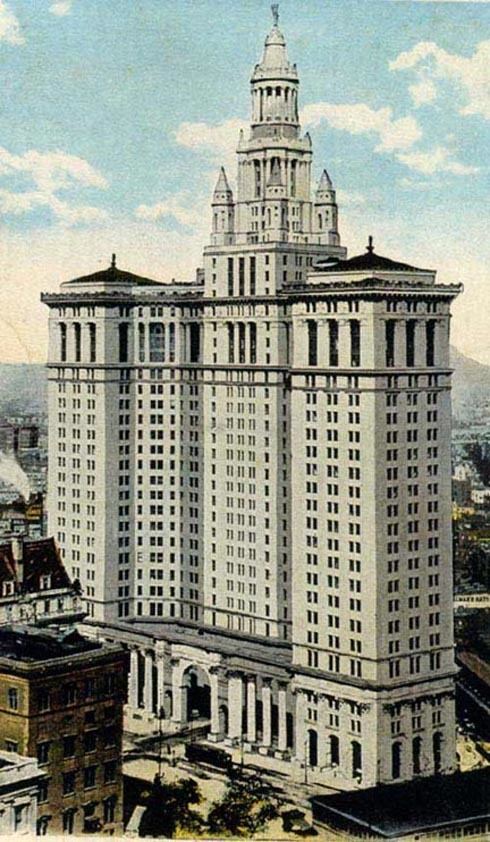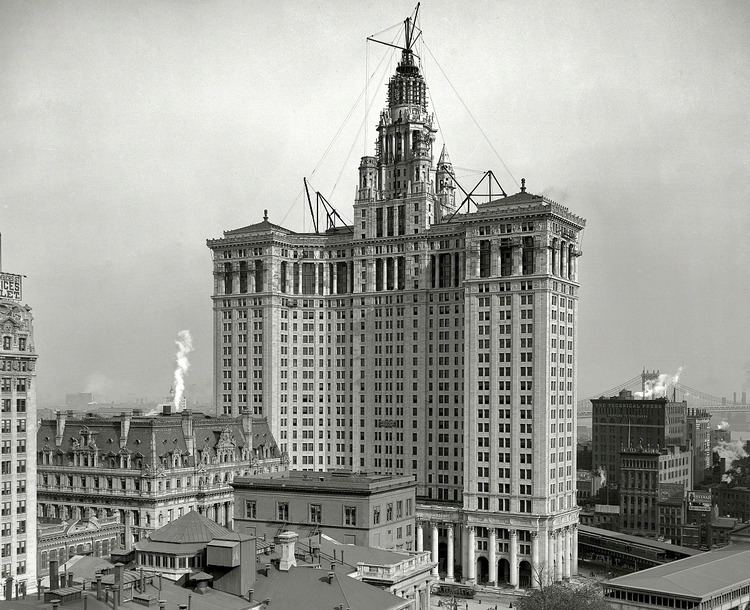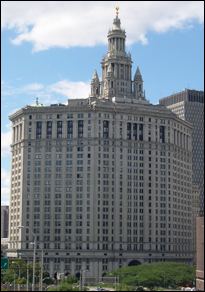NRHP Reference # 72000879 Designated NYCL February 1, 1966 Floors 34 | Built 1907–1914 Added to NRHP October 18, 1972 Height 177 m Opened 1914 | |
 | ||
Similar New York City Hall, Woolworth Building, Singer Building, Flatiron Building, City Hall Park | ||
Domestic violence city s first public graduate film school manhattan municipal building
The David N. Dinkins Municipal Building, originally the Municipal Building and then the Manhattan Municipal Building, at 1 Centre Street in Manhattan, New York City, is a 40-story building built to accommodate increased governmental space demands after the 1898 consolidation of the city's five boroughs. Construction began in 1907 and ended in 1914, marking the end of the City Beautiful movement in New York. William M. Kendall of the noted architectural firm McKim, Mead & White designed the building, which was the first to incorporate a subway station – the Chambers Street station, served by the J Z trains – into its base.
Contents
- Domestic violence city s first public graduate film school manhattan municipal building
- History
- Art and architecture
- Civic Fame
- Agencies
- In popular culture
- References

Enormously influential in the civic construction of other American cities, the building's architectural style has been "variously described as Roman Imperial, Italian Renaissance, French Renaissance, or Beaux-Arts." It served as the prototype for the Terminal Tower in Cleveland, and the Wrigley Building in Chicago, in addition to the Seven Sisters of Stalin-era Soviet architecture.

Located at the intersection of Chambers and Centre Streets, the Municipal Building stands 580 feet (180 m) tall and is one of the largest governmental buildings in the world.

At present, the Municipal Building is home to "over 2,000 employees from a dozen municipal agencies in nearly 1 million square feet of office space."

History

In the 1884 annual report of the City of New York, Mayor Franklin Edson declared that more space was badly needed for governmental functions. But he also noted that City Hall was not expandable because its "style of architecture was such that without marring its present symmetry, it couldn't be enlarged to the required extent."

The City's agencies rented space in various buildings strewn all the way from Downtown Manhattan up to Midtown Manhattan, with the number of such arrangements increasing by the year. The government, desiring to cut down the amount of rent paid to private landlords, held several design competitions for a new, massive building that would be suitable to house many agencies under one roof. Mayor Abram Hewitt appointed a commission to study suitable plans and plots of land in 1888, and four competitions were held between that year and 1907. The final competition was held by the Commissioner of Bridges, who had already secured a new plot of land to be used for a new trolley hub at the Manhattan base of Brooklyn Bridge. Twelve architectural firms entered the last competition, and the winning entry was received from William Mitchell Kendall, a young partner of McKim, Mead & White, which had been urged to enter the contest by Mayor George B. McClellan, Jr. McKim, Mead was at the time the largest architectural firm in the world, with a staff numbering over 100. Despite their standing in the architectural community, the Manhattan Municipal Building would be their first skyscraper.
The building was first occupied in January 1913, and the majority of the building's offices were opened to the public by 1916.
The building was designated a New York City landmark in 1966, and was added to the National Register of Historic Places in 1972. On October 14, 2015, the building was renamed after former mayor David N. Dinkins.
Art and architecture
The building features various types of sculpture and relief. The New York City Department of Citywide Administrative Services reports:
The central arch is decorated with sculpture in the Roman manner as was used in the Arch of Constantine. Over the side arches are rectangular allegorical panels. At the left (north), Civic Duty is represented by a woman personifying the City, accompanied by a child holding the seal of the city. On the right of the arch (south), Civic Pride shows the female personification of the city receiving tribute from her citizens. Adolph Weinman, the sculptor of Civic Fame, also designed the shields that were used in the elevators, on the molding above the colonnade and again on the false colonnade above the 22nd floor. They represent New Amsterdam, the Province of New York (under English rule), the City of New York, the County of New York and the State of New York.
The central arch is large enough that automobile traffic once went through it, although in modern times the shortened Chambers Street no longer continues through to the eastern side. A screen of Corinthian columns flanks the arch.
The terra-cotta vault was modeled on the entrance of the Palazzo Farnese in Rome, and the south arcade has a ceiling of white Guastavino tiles.
The facade of the building was restored in 1990 by Wank Adams Slavin.
Civic Fame
At the top of the Municipal Building is the statue Civic Fame, installed in March 1913. The statue is a gilded copper figure, made from about 500 pieces of hammered copper. The statue is variously reported to be supported on an iron skeleton and made over a steel frame.
The statue was designed by Adolph Alexander Weinman (1870-1952). It was commissioned by New York City at a cost of $9,000 to celebrate the consolidation of the five boroughs into the City of New York. The figure—described as "graceful and unusually charming"—is barefoot and balances upon a globe. She carries various symbolic items: a shield bearing the New York City coat of arms, a branch of leaves, and a mural crown, which she holds aloft. The mural crown has five crenellations or turrets, which evoke city walls and represent the five boroughs. The crown also includes dolphins as a symbol of "New York's maritime setting". It is 25 feet (7.6 m) tall and is reported to be either 580 feet (180 m) or 582 feet (177 m) above street level. Audrey Munson (1891–1996) posed for the figure. Munson also posed for a very large number of other important allegorical Beaux-Arts sculptures in New York, including those at the Alexander Hamilton U.S. Custom House, New York Public Library, Manhattan Bridge, and USS Maine National Monument at Columbus Circle.
The statue has been variously described as the largest or second-largest statue in Manhattan, depending on whether the larger Statue of Liberty is considered as being in Manhattan. It is similar in style to the Statue of Liberty.
According to the New York City Department of Citywide Administrative Services, "the left arm of the statue fell off and went through a skylight on the 26th floor of the Municipal Building" (then a cafeteria) in 1936, which led to the first renovation of the statue. In 1991, while the facade was undergoing renovations, Civic Fame, then suffering from exposure after eight decades atop the Municipal Building, was also restored by the city government. The statue was removed, "regilded with 23.5-karat golf leaf, and hoisted back into position by helicopter".
In addition to Civic Fame, Weinman also sculpted the allegorical bas-relief panels at the base of the building, as well as much of the building's other ornamentation, "including a series of medallions, patterns, coats of arms, and several major groups of figures" which represent various concepts: Civic Pride, Progress, Guidance (to the left of the entrance), Executive Power (right of the entrance), and Prudence.
Agencies
The following New York City public offices are located in the Manhattan Municipal Building:
The Office of the City Clerk was formerly housed in the Municipal Building; about 16,000 weddings were performed annually at the former Manhattan Marriage Bureau in the Municipal Building, in civil ceremonies lasting about four minutes, before the City Clerk's Office relocated to nearby 141 Worth Street in 2009.
In popular culture
Film
